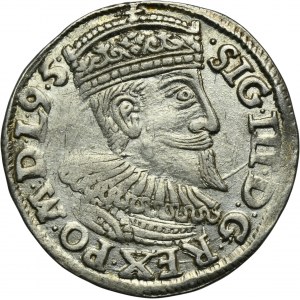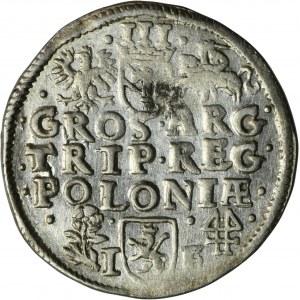Variety with abbreviated date on obverse and Andrew Lauffert's grating mark on reverse. At the bottom, the Lewart coat of arms of Jan Firlej, separating his initials IF.
The king's crown with triplets, on the obverse SIG III.
The second vintage of Sigismund III Vasa's Wschowa Trojans.
On the reverse a nicely preserved mint mirror.
The background of the monetary history of the Commonwealth during the reign of Sigismund Vasa was the progressive monetary crisis caused by the situation in Germany and the influx of the spodleniated German coinage into Poland. Initially, the mint rate was determined by Stefan Batory's ordinance of 1580. With the crisis deepening, in 1601 it was decided to raise the mint rate, i.e. devalue the denominations in circulation. The following years saw further legislation lowering the silver content of various denominations. Of these, the most important was the Ordinance of 1623. It introduced a stable monetary system, based on the monetary system of the Empire. During the reign of Sigismund III, new denominations appeared in the Polish-Lithuanian Commonwealth - three-cornered coins, halves and orts. On the other hand, in 1621, the highest denomination in the history of Polish money - the hundred-drachma - was minted at the Bydgoszcz mint. This was the crowning achievement of the intensive issuance of gold coins during the reign of Sigismund III. Crown mints (Olkusz, Wschowa, Poznań, Malbork, Bydgoszcz, Lublin, Kraków, Warsaw), Lithuanian mints (Vilnius), municipal mints (Gdańsk, Elbląg, Toruń, Riga, Poznań, Wschowa) and a private mint in Łobżenica worked during this period. Sigismund Vasa's Swedish coins were issued by mints in Stockholm, Rewal and Malbork. In 1627, a decision was made to stop issuing small coinage. This decision remained in force until 1650.
During the reign of Sigismund III, trojaks were minted at 7 crown mints (Olkusz, Poznań, Malbork, Bydgoszcz, Wschowa, Lublin, Kraków), 1 Lithuanian mint (Vilnius) and 2 municipal mints (Riga, Gdańsk). As in the reign of Stefan Batory, they constituted international money, eagerly accepted throughout much of Central and Eastern Europe. Trojaks were minted on the basis of four minting ordinances: 1580 (sample of XIII ½ of a ruff, pure silver content - 2.059 g), 1604 (XIII ½ of a ruff, 1.885 g, respectively), 1616 (XIII of a ruff, 1.561 g), 1623 (VII ¼ of a ruff, 0.914 g). As King Sigismund III of Sweden, he minted city trojaks in Rewal (proof coins).









